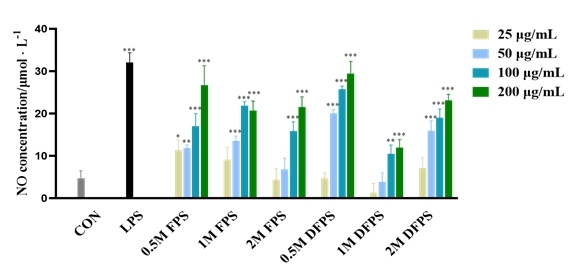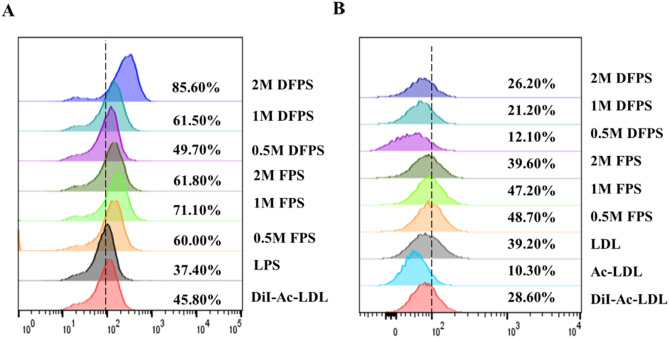Scavenger receptors (SRs) have been shown to participate in regulating the immune response of macrophages. Fucoidans from kelp have good immunomodulatory activity, however, the roles of SRs in the immunomodulatory activity of fucoidan from Saccharina japonica are not clear. Therefore, revealing the role of SRs in the immunomodulation of fucoidan is of great significance for targeting macrophages to develop new marine drugs.
Recently, the research team led by Prof. ZHANG Quanbin from the Institute of Oceanology of the Chinese Academy of Sciences (IOCAS) performed a comparative study of the immunomodulatory activities of six different fucoidans from Saccharina japonica and explored the association with class A SRs (SR-A).
The study was published in International Journal of Biological Macromolecules on Jun 16.
Six different fucoidans with different molecular weights and chemical compositions were prepared by degradation and separation from Saccharina japonica for the following in vitro comparative study, which were named 0.5 M FPS, 1 M FPS, 2 M FPS, 0.5 M DFPS, 1 M DFPS and 2 M FPS, respectively. Results showed that different fucoidans displayed different stimulation of macrophages to secrete nitric oxide (NO), Interleukin 6 (IL-6), Interleukin 1β (IL-1β), tumor necrosis factor α (TNF-α), and the related genes. In particular, 0.5 M DFPS could significantly stimulate macrophages and up-regulate the expression of IL-6.
Activation of macrophages is dependent on the involvement of surface pattern recognition receptors. Toll like receptor 4 (TLR4) is involved in the immunomodulatory activity of fucoidan as previously reported, and flow cytometric analysis in this study indicated that TLR4 was up-regulated as expected after treatment with all the fucoidans. However, the expressions of different SRs in macrophages treated by different fucoidans were very different. Furthermore, only 0.5 M DFPS and 1 M DFPS were confirmed to be ligands of SR-A through the competitive binding assay. In addition, the expressions of SRs treated by other fucoidans were upregulated not because they were ligands of SR-A.
The function of SR-A in macrophages requires the participation of ligands. Fucoidans obtained from kelp are structurally different, and their structural characteristics as ligands may also be different. "Our results showed that two fractions with low molecular weight and heterogeneity might be able to bind to SRs and promote their expressions better," said CUI Meiyu, first author of the study.
Excellent bioactivities are the basis of the high-value utilization and development of resources of China's main economic brown algae-kelp. "This study is of great significance for us to better understand the immunomodulatory effects of fucoidans of different structures from the perspective of ligands of scavenger receptors on macrophages, thereby promoting the development of related immunotherapy drugs," said Dr. GENG Lihua, the corresponding author.
The research was funded by the Shandong Provincial Natural Science Foundation, the China Postdoctoral Science Foundation, the Shandong Province Major Science and Technology Innovation Project.

Fig. 1 Effects of different fucoidans (25, 50, 100, 200 μg/mL) on the production of NO in macrophages. LPS (1 μg/mL) treatment was used as a positive control.

Fig. 2 The ability of six fucoidans from Saccharina japonica to uptake Ac-LDL (A) and the ability to bind SR-A in competition with DiI-Ac-LDL (B) detected by flow cytometry
Meiyu Cui, Xiaohong Li, Lihua Geng*, Ning Wu, Jing Wang, Zhenzhen Deng, Zhi Li, Quanbin Zhang. (2022). Comparative study of the immunomodulatory effects of different fucoidans from Saccharina japonica mediated by scavenger receptors on RAW 264.7 macrophages. International Journal of Biological Macromolecules.
(Text by GENG Lihua)
Media Contact:
ZHANG Yiyi
Institute of Oceanology
E-mail: zhangyiyi@qdio.ac.cn
(Editor: ZHANG Yiyi)
|
|

Address: 7 Nanhai Road, Qingdao, Shandong 266071, China
Tel: 86-532-82898902 Fax: 86-532-82898612 E-mail: iocas@qdio.ac.cn


